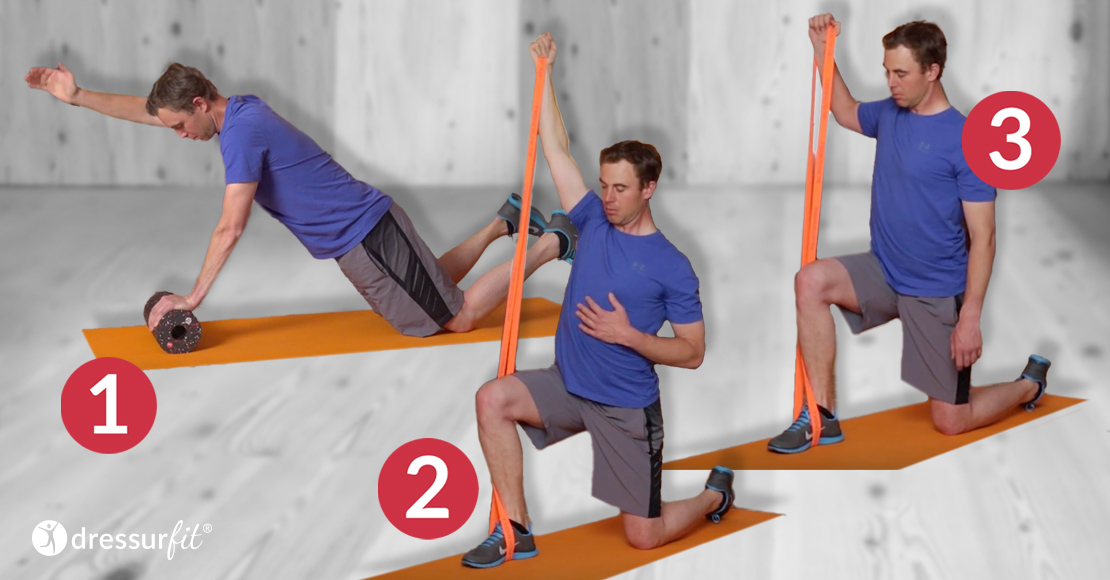
The Upright Upper Body & Light Rein Aids: 3 Exercises to Stabilize Your Shoulders
“Upper body back, sit tall!” That’s a familiar instruction in riding lessons. After all, an upright, centered seat with correct ear-shoulder-hip-heel (ankle joint) alignment – one line that should be perpendicular to the ground – is necessary to give precise aids. That’s how the German FN manual describes it. However, achieving this perfect alignment isn’t as simple as it may sound, especially if your body is not meeting certain prerequisites. For a tall, erect upper body and light rein aids out of supple shoulder joints, the rider’s shoulders need to be both mobile *and* very stable. “A closer look at the anatomy of the shoulder joint illustrates how important shoulder stability is,” explains fitness expert Marcel Andrä. “The head of the humerus is much larger than the joint socket, approximately like a golf ball (head of humerus) to a golf tee (joint socket), the little pin upon which you place the golf ball to tee off. The circumference of the ball is clearly much larger than the small contact area of the pin. To achieve good mobility, stability is indispensable to keep everything in its proper place.”
Therefore it is necessary to strengthen the muscles and soft tissues surrounding the shoulder to achieve the stability it needs to function optimally. Most importantly, we need solid stability and good control over the movement of the shoulder to keep this joint healthy. “The shoulder is one of our most flexible joints that can move in many different plains of motion,” Marcel Andrä explains. “However, this ability can negatively affect stability. Furthermore, riders need to be able to move other body parts efficiently, sometimes in conjunction with but sometimes also independently of the shoulder. Studies have shown that the upper part of the trapezius muscle is used more than the middle and lower parts. This can lead to a timing problem related to the contraction of the muscle. In this case, it becomes impossible – or can only be done under great strain – to bring the shoulders back, which prevents the rider from having a supple seat and upright alignment.”
Mobility requires stability
Good shoulder mobility requires muscle contraction and coordination. In other words: mobility requires stability. Stability is defined as the ability of a neuro-muscular system to keep and control a joint in a certain motion or position. If we lose stability in the shoulder joint, or if our brain notices instability, it reduces the range of motion to prevent injury (self-preservation). “The further a joint is moved from its neutral position, the more difficult it is to stabilize it,” Marcel Andrä cautions. “Mobility problems in the shoulder or shoulder girdle are in fact often stability problems.”
If you tend to tip your shoulders too far forward, or if you have to actively pull your shoulders back to align with the perpendicular line, try to integrate these three exercises into your training routine in order to achieve correct stability and coordination:
1. Exercise
Go into a Kneeling Plank. Place your arms on the BLACKROLL® and bring one arm at a time up toward the ceiling. Repeat this exercise 6 to 10 times per side.
Important: Keep knees, hips, and shoulders in one line. In this exercise, arm and shoulder are working – even more on a movable surface.
2. Exercise
Go into the Half Kneeling Position. Step into the Superband with your front foot. With your arm on the same side, pull the band straight upwards. Then bend your upper body to the other side, keeping your arm straight up in the air. Repeat this exercise 6 to 10 times per side.
3. Exercise
Go into the Half Kneeling Position. Step into the band with your front foot. Your arm on the same side holds the band. The upper arm is held in a 90 degree angle from your upper body. Then rotate your forearm up and back. Repeat this exercise 6 to 10 times per side.
Take the first step to improve your rider fitness and identify your individual strengths, weaknesses and imbalances with your first DressurFit® fitness test for free. Start your free rider fitness test now!
